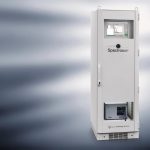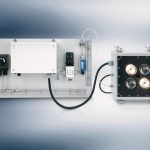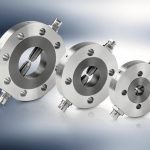NIR spectroscopy allows the identity and concentration of substances to be safely determined. The Spectrobay system based on NIR spectroscopy, which Krohne recently added to its portfolio, can lay the foundation for optimised automation processes and a comprehensive process control concept. Chemical plants equipped with this system operate more profitably.
Author Ralf Haut Chemical Industry Manager, Krohne
Near-infrared (NIR) spectroscopy is a well-established method for quantifying chemical compositions and has become an important part of the PAT initiative over the last decade for this reason. With NIR spectroscopy it is possible to recognise a molecule’s fingerprint and therefore safely determine the identity and concentration of substances. It can also be used to maximise a system’s performance, for example the so-called space-time yield.
The ideal operating point of a chemical plant from the point of view of the planner is 100 % capacity utilisation. If a plant is only operated at 90 %, some resources inevitably remain idle. In order to achieve the ideal operating point and hence the economic optimum, the chemical processes must run optimally. This requires the exact composition of all substances in the system to be known anywhere and at any time.
PAT tools are increasingly used alongside classic process measuring technology (volume, level, temperature, etc.). The requirements for PAT vary considerably. Batch processes call for an extension of the measurements in the time axis across all concentration ranges. The composition of the substance on the probe changes constantly. In continuous processes, on the other hand, the same composition or the same concentration often appears at only one point in the production chain and the measurements take place during the individual process steps. The ideal situation where all relevant information or data is always known would be excessively expensive in a chemical plant. By positioning PAT measuring points optimally, a higher control level can be achieved and previously unused potential exploited – a cornerstone of Advanced Process Control (APC). Since the results are delayed due to the sampling, transport and analysis times as well as the long intervals between samples, it is virtually impossible to control processes at this level using gas chromatography (GC).
NIR spectroscopy offers key benefits
In the electromagnetic wave spectrum, the NIR region lies below visible light. Each molecule absorbs certain fractions of the light which shines on or through it and therefore allows conclusions to be drawn about its structural composition. Instead of individual wavelengths a whole spectrum is considered, thereby producing an enormous amount of information which allows the measurement results to be safely interpreted – even after changes in the substance matrix. NIR spectroscopy is suitable for liquids and suspensions as well as solids or gases. The length of the measuring path is variable to a few centimetres, making NIR a suitable method for in-line measurements of liquids and gases. Blockage of the measuring path due to deposits is largely avoided. With in-line measurements, sampling is reduced to a minimum for work safety reasons. Personnel and laboratory costs are also lower.
More than just a stand-alone solution
Krohne’s Spectrobay NIR spectrometer system is an automation platform for controlling complex chemical processes. It allows these processes to be monitored precisely: closely linked to the operational control, the system forms the basis for APC. Developed by Bayer Technology Services (BTS), it works with qualified, standardised hardware and software. The system is successfully proven in the field for more than ten years and is continuously updated. The partnership between BTS and Krohne bundles operating and planning expertise, especially in the area of NIR. When Spectrobay is used in chemical plants, this is the best guarantee of quick and effective improvements in process control. Taking the structural possibilities and process control into consideration, the aforementioned operating experience enables the measuring points to be optimally positioned and configured. For example, in order to measure solids such as powders, crumbs or lumps on a conveyor belt using the reflection method, a special solids probe equipped with its own light source is available.
Multiplexing capability
One important advantage of the system stems from its multiplexing capability with six channels. On a distillation column, for instance, two measuring points can be installed at the feed and head. The four remaining free points can be retrofitted inexpensively later for finer control. They can even be used for measuring tasks on other columns. These six channels can be further extended with a multiplexer. Over 150 systems equipped with more than 600 measuring points have already been installed – an average of four points per system. Processes can thus be monitored and optimised at several points in real time. In addition, this opens up completely new control options, which with extractive methods such as GC are virtually impossible. The system is installed in a control cabinet and consists of the following components in the basic version:
- Industry standard PC with keyboard for system control
- Communication and switching technology, including a connection to the process control system
- Display for indicating measured values and statuses locally
- Spectrometer depending on the requirements of the process
- Application-specific probe(s)
The key software element is ARTS (Analyser Result Transfer Software), a BTS product. This software controls the analyser and makes results and concentrations available. It creates the basis for downstream control processes and local switching operations. Signals for processes can be activated or received via switching inputs. There are various output options: one or several 4 to 20 mA outputs, OPC interfaces, Ethernet, Modbus, Profibus DP, Profinet or customised. Official documentation can also be created using the software and consumption values or workflows documented. Remote maintenance and calibration are likewise available on request.
Typical applications
Spectrobay allows a higher-level control strat-egy. With precise measured values for the entire production process, a plant’s capacity can be almost fully utilised, so that waste and downtime are minimised. Typical applications include distillation control and regulation as well as crystallisation and drying processes. Reactions such as polymerisations can be traced and their end points determined. End products can also be characterised in qualitative terms and consistent standards ensured. Functions like product change indications or quality monitoring can be realised in this way. The NIR spectroscopy system can be used to measure a wide range of liquid, solid or gas-eous substances such as powders, tablets and a variety of monomers and polymers.
The potential applications are demonstrated below with the help of three specific examples. In the first process – fluidised bed granulation – the material is granulated by drying. Controlling the drying process with Spectrobay has a direct impact on the quality of the granules and reduces energy consumption to a minimum. By fitting probes at the bottom of the vessel, the system records the spectra in real time and provides precise information about the moisture content. The amount of moisture can be presented accurately as a curve. The system also detects the end point of the drying process and knows when the product is fully granulated, so that a new batch can be processed. The overall result is better utilisation of the plant.
Shorter batch times save energy
One particularly demanding application – in a chemical-analytical sense – is isomer sepa-ration by distillation. In the following example nine components are monitored in an isomer separation process involving chlorinated aromatics. If the laboratory results are determined in the conventional way, only selective data is available to the plant operator for controlling this 30-hour batch process. The progress of the reaction in the reactor can only be evaluated based on experience. Due to the time difference between sampling and the laboratory result, the control quality was previously poor and the batch distillation capacity could not be fully utilised. Since the reflux rate of the column was only controlled in the conventional manner, the energy efficiency of the system was also unsatisfactory.
Online measurements in real time now enable all stages of the reaction to be clearly identified and the processes precisely controlled. The Krohne system has reduced the energy requirement in this example by 20 % through precise switching and cutting in the pre-run, main run and post-run. The product quality is now consistent and the number of samples in the laboratory much lower. The most outstanding effect has been the reduction in batch time from 30 to 24 h, resulting in a capacity increase of 19 %.
Reliable process control
Spectrobay can be used to trace the reaction course of a chemical process. In the example described here there were special requirements because the production process entailed two liquid phases which do not dissolve in one another and separate quickly. In order to ensure the necessary time for the reaction, there is a retention time cascade of approximately eight hours. During this cascade, the materials are mixed by stirring, then allowed to rest and subsequently mixed again. The condition of the mixture is therefore very difficult to determine during this period. Samples collected conventionally show only a rough result, which is also corrupted by the separation. NIR measurements solve the problem since the process and plant can be controlled directly in the reactor based on the continuous measurement. Another important side effect of measuring directly in the mixing vessel is the significant improvement in work safety because the closed system means routine sampling of hazardous components is no longer necessary.
cpp-net.com/0115402
Share:









